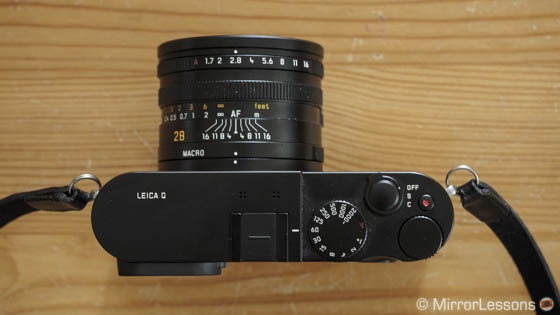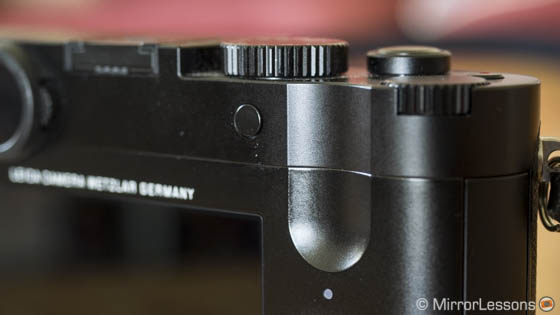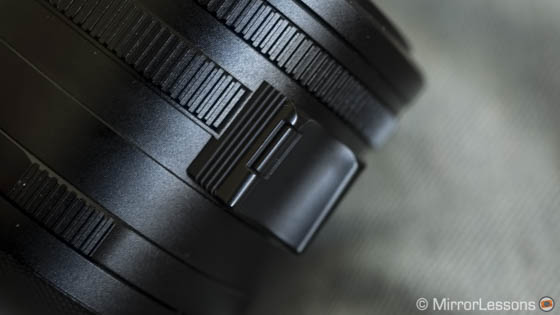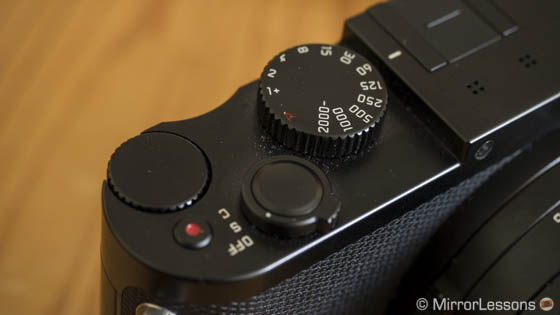Excluding the M rangefinder series, which is aimed at specific users, Leica’s attempts to enter the consumer digital imaging market haven’t been that exciting so far. Its X series includes expensive compact cameras that house a large APS-C sensor but lack several features and deliver limited autofocus performance. The build quality is excellent but these cameras pale in comparison to the aggressive competition in the APS-C segment (think Fujifilm, Sony and Samsung).
The Leica T was an original experiment and while there are some very interesting aspects about that camera (read our review here), it still lags behind when it comes to the most basic characteristics that you’d expect from a modern digital camera: slow AF, slow performance and very expensive.
Acknowledging all this, the new Leica Q is a breath of fresh air. Leica has finally given a full frame sensor to a camera outside the M series and includes technology that is worth talking about and praising. We get a large and excellent electronic viewfinder, a super fast autofocus system and a very responsive interface. It is nothing new by any means but it is nice to see Leica finally catching up with some of the competition. Yes, the camera is still expensive, but this time I would be more willing to say it is worth the investment.
My first thought when I picked up this camera was: “Finally, a modern digital camera done right by Leica!”



Leica Q (Typ 116) Main Specs
- Sensor: 24 megapixel 35mm full frame CMOS
- Lens system: fixed Summilux 28mm f/1.7 ASPH
- Weatherproof: None
- Internal Stabilisation: Yes (Optical)
- Autofocus: Contrast detection AF with 49 autofocus areas
- Continuous shooting: 10 fps
- ISO Sensitivity: 100 – 50000 ISO
- Shutter Speeds: 1/2000 to 30 seconds, up to 1/16000s with electronic shutter
- Viewfinder: LCOS electronic viewfinder with 3,680k dots
- LCD Screen: fixed 3″ touch sensitive LCD monitor (1040k dots)
- Movie recording: Full HD up to 60fps
- Built-in Flash: No
- Extra Features: WiFi/NFC, Bracketing
- Dimensions: 130 x 80 x 93mm
- Weight: 640g (including battery and memory card)
[toc heading_levels=”3″]
Ergonomics & Design
The Leica Q Typ 116 inherits one of the aspects for which Leica is best known: build quality. The camera has a magnesium alloy chassis and an aluminium finish on the outside. It is elegant and the attention to detail is easy to appreciate. From the dials to the connector port doors, the camera feels solid and good in the hands. One small complaint is the lack of weather sealing, a characteristic that is becoming more common these days and that you would expect from a high-end premium camera like this.

The body has the same rectangular shape with curved edges that we see on the M and X series. Despite the lack of a prominent grip, the camera is actually very comfortable to use and that is mainly thanks to the indented thumb rest on the rear.

The 28mm fixed lens gives you a very pleasant experience similar to that of the M lenses. The aperture ring is smooth and precise, and the focus and macro rings give you that nice mechanical feeling you get when using the brand’s best rangefinder lenses.

I admit I have few complaints about the design of this camera. It is elegant and very well done. You definitely get the feeling of a high quality premium build that makes other cameras like the Sony RX1 or Fujifilm X100T look and feel like toy cameras. Perhaps a tilting LCD screen on the rear would have been a nice addition but otherwise it is flawless.
Ease of Use
Access to the main exposure settings via a dedicated ring and dial will certainly satisfy high-end users. The other dial on the far-right can be used for several things: exposure compensation, bracketing or fine-tuning the shutter speed when working in manual exposure mode. One little criticism about the exposure compensation dial is that when you turn it, it first activates the dedicated graphic on the LCD and then changes the value when you turn it a second time. I wish it would change the value directly when you turn it the first time.
The button layout on the rear is very simple and straightforward. The arrow pad on the right lets you change the position of your focus point and the centre button changes the amount of information displayed on the LCD or EVF. There are two customisable buttons: one on the left (Fn) and one on the top rear near the thumb rest. Here we find a limitation: there isn’t a great number of settings you can choose between. For example there is no way to assign the AF type or AF area options to one of these two buttons and avoid digging in the menu.

The LCD screen has touch sensitive capabilities. Like the Leica T, you can swipe up or down to switch to playback mode, enlarge a picture with your fingers, and double tap the screen to bring the AF point back in the middle. You can change settings such as ISO or WB by using the screen instead of the dial. There are also Touch AF and Touch AF/Release options that allow you to select your focus point and take a shot by simply touching the monitor. While this feature has proven very useful on other cameras like Panasonic and Olympus, here there is one little frustration. When Touch AF is activated, the camera will only focus via the touch screen and not by half pressing the shutter release button. I prefer to use the touch AF in addition to the default focusing method so this is why I ended up not using the Touch AF a lot. I had to go into the menu to activate/deactivate it whenever I wanted to use it. There is however a work-around and that is to assign focusing to the second Function button.

The Leica Q features a built-in EVF with the highest resolution available on the market, a whopping 3.84 million dots. It uses LCOS technology and the resolution is actually divided between the 3 RGB colours (1,225k dots per colour). I found the live view to be crisp and detailed and makes the EVF very nice to use. I particularly enjoyed it while manual focusing and using peaking or magnification, as the details were very crips and easy to detect and work with. It is definitely one of the best EVFs I have ever used. It is not the largest on the market but big enough to use comfortably even for someone like me who wears glasses. The time-lag is also good.
Image Quality: sensor
The Leica Q has a 24 megapixel sensor but it is not the same as the one found inside the Leica M. The most relevant difference between it and the flagship rangefinder is that the Q has a vaster ISO range and can shoot up to ISO 50,000. While the latter is definitely full of noise and almost unusable, the camera proved an excellent performer up to ISO 3200. The images retain a good amount of detail and the fine noise is not invasive. At 6400, the amount of noise is still acceptable but some banding can appear. It becomes even more visible at 12500 and the noise starts to become really intrusive. Below you can see some examples taken at the Lantern festival in Aberdovey.

Full res size available (click on the image)


Full res size available (click on the image)


Full res size available (click on the image)

Full res size available (click on the image)

What I really like about Leica’s image quality is the colour palette. I love the colour rendition of the Leica M/T and the Q doesn’t let you down either. Colours are rich with a very natural rendition, probably some of the most natural looking images you can find. AutoWB works really well too. Curiously, there aren’t different picture profiles. You can change the contrast/sharpness/saturation of the JPG but you don’t get some of the Film Style profiles you find on the M Typ 240. By default the JPGs have a very sharp rendition and strong contrast but you can tweak the settings as mentioned.





In the Saturation setting, you also find the Monochrom option and I enjoyed using it for some of my shots. While the results won’t be as rich as the images taken with the Monochrom Typ 246 (see our review here), the Leica Q renders nice contrast and retains lots of detail. Of course you also have the option of post-processing the Raw files with several different B&W presets.


Having a full frame sensor with no low-pass filter and 24 megapixels, you’d expect great dynamic range as well. The Raw files have a depth of 14bit. However I admit that DR is not the strongest point of this camera. Don’t get me wrong, it isn’t bad but when it comes to Raw file versatility, you can come across some banding if you try to recover details in the shadows too much. This is why I sometimes used the bracketing option and merged the three files together to have cleaner results. Unfortunately bracketing won’t work with more than 3 shots in a row unless you do it manually of course.




Below you can see a 100% crop example with exposure and shadow recovery on a single Raw file (+2Ev and +50) where the banding becomes visible. The second image is the HDR version shown above where the shadows are cleaner.
[twentytwenty]


[/twentytwenty]
Image Quality: lens
If there is one thing to praise about the Leica Q more than anything else, it’s the lens. This 28mm Summilux is a stellar performer. Leica is known for its expertise and experience in producing beautiful optics and the Leica Q is definitely confirmation of this. However the best characteristic of this camera is also its greatest limitation. Since you can’t change the lens, you need to be sure that 28mm gives you an angle of view you like to work with. This might sounds obvious but it is important to remember. Some photographers love the 28mm focal length but others prefer 35mm or 24mm. Personally I think that 28mm is a good compromise that lets you take reasonably wide-angle shots but I admit that I occasionally missed a longer focal length. It’s a matter of personal taste but the focal length is definitely the first thing you should consider if you are interested in this camera.
The 28mm has a maximum aperture of 1.7 and already gives you an excellent sharpness wide open. Vignetting is almost completely absent and chromatic aberration is non-issue. If you focus close enough to a subject, you also get a very nice shallow depth of field with a creamy bokeh and excellent transition from the focus point to the out-of-focus area. The capabilities of detaching the subject from the background are also excellent considering the short focal length. It’s not a portrait lens by any means but you can get good ambient portrait shots.





Sharpness remains excellent through all the apertures. It peaks at around 5.6 and you get some small amounts of diffraction at f/16. Sharpness in the corners is acceptable at the fastest apertures and increases from f/2.8.

Full res available (click on the image)


The lens also has good flare resistance but sometimes you can encounter some green flares, ghosting and sensor flares like in the HDR example shown before. Below is another less invasive green flare due to the sun reflected in the water.

Distortion is overall well contained and I haven’t notice any relevant barrel distortion. Finally, the Summilux 28mm has a macro mode that you activate with the dedicated ring. The fastest aperture available becomes f/2.8 and the minimum focus distance is 17cm. You won’t get excellent close-up details but it is a nice addition that lets you focus closer to some elements.


Limitations for astrophotography
The Leica Q may not strike you as an astro-photography camera at first but the main characteristics required for the genre are there: a wide-angle lens (although some of you will definitely prefer an even shorter focal length for this genre), a fast aperture of 1.7 that gives you excellent sharpness, and good high ISO capabilities. However I came across an annoying limitation with this camera.

I managed to take this decent Milky Way shot above during a clear night two weeks ago (the same time that the Perseid meteor shower happened). Now you’ll notice that I shot this image at ISO 6400 and only 4s of exposure. The first question you might ask is: why didn’t you use a longer exposure and lower your ISO for better quality? Well, unfortunately, the Leica Q limits slow shutter speeds when using higher ISO sensitivities. As a matter of fact, here are the slowest speeds you can use depending on the ISO value:
- 800 ISO: 15s
- 1600 ISO: 8s
- 3200/6400 ISO: 4s
- 12500 ISO: 2s
- 50000 ISO: 1s
The only reason I can think of for this is that with longer exposures you would wind up with too much noise and maybe also banding issues. It is a shame because with the stunning lens attached to it, this camera could work very well in these conditions. So despite all the various improvements, Leica still has some work to do regarding high ISO performance and image processing.
Autofocus and performance
The previous large sensor compact cameras from Leica had a slow autofocus mechanism but the same cannot being said about the Leica Q. Not only do you get a fast autofocus but you actually get one of the best AF mechanisms I’ve tried on a mirrorless camera. Leica managed not only to improve one of the aspects for which they were not recognised, but actually turn it into a reference. Now I don’t know exactly who designed the AF system. We know that Leica has a partnership with Panasonic and to be honest, while using the Q, I often saw the same AF behaviour I find in Lumix cameras, which are among the best when it comes to autofocus performance. So if Panasonic was the brains behind it, I wouldn’t be surprised at all. That being said, what matters isn’t who designed it but how it works.
In Single AF mode, you get excellent results in almost any situation and that includes low light as well. As a matter of fact, the only time I found a decrease in performance was in backlit situations but it only happened a couple of times. Even in macro mode the AF remains fast as long as you are focusing within the distance range.
The Leica Q is not primarily a sports/action camera but it does provide interesting options for shooting in continuous mode. First, the drive mode is excellent with a 10fps burst in S-AF. With the Raw files, the buffer memory will fill up quickly but if you shoot JPG, it lasts for a very long time – in fact, the camera never stops taking pictures. In Continuous-AF, the burst speed decreases to around 4/5fps. There are also Tracking AF and Face Detection options. They work well but aren’t always 100% accurate.

To switch to manual focus, you use the button on the lens’ finger grip that unlocks the focusing ring. The camera has both magnification and focus assist options and they work really well especially with the EVF and its very high resolution.
Finally, the Summilux 28mm also includes optical stabilisation. In my tests I found that it performs well down to 1/2s which is a very good result.

One negative aspect is the battery life. The Leica Q uses the same battery type as the V-Lux and the Panasonic LX100. The charge decreases rapidly and if you are out all day shooting, a second battery is strongly advised.
Video, WiFi and other features
I admit I didn’t give the Leica Q’s video capabilities too much attention in my testing as Leica cameras are not tools I would consider for video work. The camera can shoot Full HD (1080p) at 60fps or 30fps. You can manually control the exposure as well as the contrast/saturation and other settings in the dedicated Movie menu. Both Single and Continuous AF are available. The camera also uses software stabilisation to reduce shaking (it can be turned off in the menu).
The quality is not bad and I can see some improvements over the Leica M. Compression seems a little bit better but there are still rolling shutter, aliasing and moirée issues. The colour rendering on the other hand is very nice.
The Leica Q has a leaf shutter which quiets the shutter sound. The maximum mechanical speed available is 1/2000s but you can go up to 1/16000s thanks to the electronic shutter. However you cannot manually select the electronic version for speeds slower than 1/2000s. There is also the option to turn the shutter sound off but I found that option useless. If you turn it off, you will still hear the shutter in mechanical mode, and when using the electronic version, the camera works in silent mode regardless of the option you select.
There is also a crop mode that will emulate the field of view of a 35mm or 50mm lens. The camera will display the white lines that you can find on an optical rangefinder to show you the limits of your frame. Personally I didn’t find this option very useful as you can do the same in post-production. Note that it will only work with JPGs; the Raw files retain the full 24MP resolution.

The last feature to talk about is Wifi/NFC. As usual, you get the chance to use your smartphone to remotely control the camera, as well as transfer the images to your mobile device. You can also select the connection back-up option which means that JPGs will be transferred and saved to your mobile device while shooting. The camera can also transfer MP4 videos. Connecting the camera to your smartphone is easy and I have to say that the Q app is very well-designed and easy to use. Just remember that using Wifi will eat up your battery life more quickly.

Leica cameras are usually not rich in extra features but in this case you get a Panorama and Time-lapse function which is more than welcome.
Conclusion
The Leica Q is the best Leica camera I have used to date. It is a different experience than the rangefinder M and probably a comparison between the two is not fair because there are two different philosophies behind them.
The Q Typ 116 is simple and straightforward to use, and gives you excellent image quality especially thanks to the 28mm lens. The build is very well conceived and shows how the quality of the material and assembling can make a difference in comparison to other cameras. You pick it up and within a few minutes you are already familiar with the basic settings and how to operate the camera. It is hard to not like it at first sight.

The camera is not perfect however. A few more customisation options would be welcome. While the optical quality is great, the sensor has some limitations probably due to the processor. Despite the vast ISO range, you can find banding past 3200 ISO or when recovering shadows from the Raw files at lower ISOs. The shutter speed limitation at high ISOs is a shame because it limits the use of the camera and its stunning lens for certain applications like astro-photography.
Finally, there is also the price factor, a recurring argument when it comes to Leica cameras. With the Q, there are two ways to see it. On one hand, it is the cheapest full frame Leica you can find considering that you get both the body and the lens. On the other, it is a very expensive compact camera that costs more $4000. Also, despite all the pros and cons mentioned in this article, whether you should choose this camera or not is mainly related to the focal length offering. A fixed 28mm might not suit everyone’s taste and if you are in doubt, it is better to consider other options. Personally, I’d prefer a 35mm instead of a 28mm if I could only use one lens.
 What I like about the Leica Q Typ 116:
What I like about the Leica Q Typ 116:
- Beautiful design and very solid build quality
- Straightforward to use
- Excellent EVF with very sharp details
- Excellent colour palette and stunning optical performance at f/1.7 onwards
- One of the best autofocus mechanisms I’ve tested
- The best Leica compact camera by a long shot
 What I don’t like about the Leica Q Typ 116:
What I don’t like about the Leica Q Typ 116:
- Personally I would have preferred a 35mm focal length
- At high ISO values, slow shutter speeds are limited
- Banding issues past 3200/6400 ISO and when recovering shadows from the Raw file
- Some additional customisation for the Fn buttons would improve the user experience
- Battery life decreases rapidly


